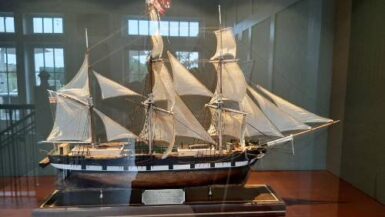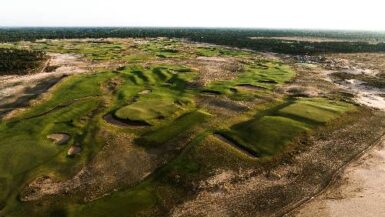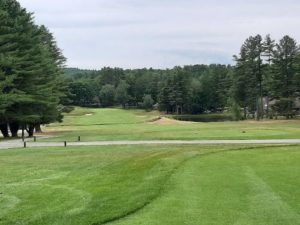
We played Lake Sunapee Country Club for the least scientific of reasons: It was the closest golf course to Mount Sunapee ski resort, which we are reviewing as a companion article to this piece.
Boy, did we ever hit the jackpot.
It was interesting to discover that Lake Sunapee Country Club is rated the top golf course in New Hampshire by several respectable publications, both print and on-line. Mind you – “Come on Eileen” was a number one hit in American popular music, so we take rankings with a grain of salt; they are meant to be examined, not just parroted. Still, a consensus number one in any state is a strong starting point.
Our interest grew to intrigue when we learned Donald Ross, one of the godfathers of golf course architecture in America, designed the golf course in 1928-29. And this wasn’t just some course where Ross breezed in for a few days, made some offhand observations, and then never returned. Instead, Lake Sunapee is one of only a handful – out of the close to 500 courses attributed to Ross – one of a select, cherished few where Ross chose the site for the golf course, designed it himself, and then oversaw course construction through to completion.
Better still our intrigue grew to excitement when learned not only that Ross’s original design was almost completely intact – all but untouched by intervening hands for 100 years – but that regional golf design star Ron Forse had just completed a sparkling restoration that has the golf design world buzzing with electricity. Lake Sunapee is now – as they say in the music industry – number one with a bullet, a rising star.
THE MANY SIDES OF ROSS
When we talk of his greatest designs, Ross is best known for his fire-breathers. Pinehurst No. 2…Seminole…Oakland Hills: miss the green at any of those, and you’re either in a monstrous bunker set well beneath the green, thirty yards back down the fairway after failing to carry the false front, or in a greenside swale facing ferocious contours that will shed your ball away from the hole. Likewise, even many of Ross’s smaller private clubs are steel-tough tests of precision, (Aronimink, Mountain Ridge, and Irondequoit, for example).
But Lake Sunapee is a softer side of Ross; gone is the white-knuckle terror on every approach shot. At Lake Sunapee, there is a right side to miss and a wrong side, much like Shenacossett, Ross’s Connecticut public masterpiece or Teugega, in Ross’s long-time home of Rome, New York. Since many greens feature open routes, often “the miss” is short, so bogey golfers can tack their way around carefully and cleverly. Finally, bunkers and other hazards are turned perpendicular to line of play, so there are strategic angles to consider off every tee box. At Lake Sunapee, it’s the intelligent golfer, not the longest who can outsmart Ross, not overpower him.
Lake Sunapee doesn’t need the sword thrusts of Seminole or Oakland Hills. Instead, much like Ross’s New Jersey masterpiece Plainfield Country Club, Lake Sunapee sits right in front of you…and confounds. You tend to bleed to death more slowly, incision by incision. You can’t help but laugh, because anything that went sideways on your scorecard was all…your…fault.
It’s the fairest Ross I’ve ever played.
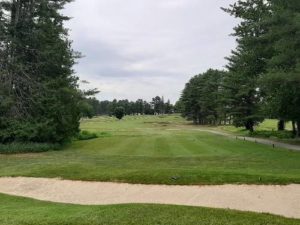
“The founders of the Lake Sunapee approached Ross immediately after he finished his work at nearby Salem Country, actually going so far as to give Ross his choice of sites from among more than a half a dozen. Because of that, Ross had a heavy investment in Lake Sunapee and delivered in a big way,” explained Forse, whose touch-up work has helped turn Lake Sunapee from a local favorite to a course aficionados need on their bucket lists. He’s right: It was club President E.J. Poor who brought Ross to New Hampshire on a train, drove him around in a horse and buggy, and ultimately purchased a sheep ranch Ross selected for the golf course. Ross then brought in his own team, many of them fresh off the Salem gig, and together they made Lake Sunapee not so much a bookend to Salem, but a rousing encore.
“Best of all, in the entire history of the course, only once did the club ever make any changes to Ross’s design; Gene Sarazen changed the front left bunker of the eighth green. But when I first got there, about 75 years after Ross left, everything else was right where he put it,” Forse concluded. Sarazen, you’ll recall, won six majors, including the 1935 Masters, the second one ever contested. After retiring from professional golf, he summered at Lake Sunapee, and his descendents still live and play there to this day.
Finished in the mid 2000s, Forse’s work consisted of restoring where he could and updating where he had to by removing hundreds of non-native trees, expanding greens to their original size, restoring lost bunkers, and re-tying greens and tees close together, making the course easily walkable for everyone, not just strapping young college kids. The tree removal was particularly well-received as it opened up sweeping vistas of the mountain’s scenery.
The renovation polishes Ross’s design to a brilliant shine. Lake Sunapee’s smooth and ergonomic routing feels gentle and rolling, but maximizes the hilltops for green settings and tee boxes, putting a premium on distance control as well as accuracy. This can tend to fluster bomb and gauge golfers who look at the scorecard, see the short yardages, (only 6,700 from the tips and 6,360 from the blues), but forget that Lake Sunapee is a par-70 with only two par-5s, so it plays longer, especially the par-3s.
“‘The 12th is one of the hardest par-3s in all New England, 240 yards, all carry, uphill over a valley to a double-tiered green longitudinally bisected. The right is the upper tier. So you must be both long and accurate,” Forse explained. “Ross built similar greens at Manchester Country Club’s par-3 13th (New Hampshire) and at the 14th at Edgewood Country Club in Pittsburgh.”
Personally, Your Author’s favorites are the opener, a stern par-4 cascading down from the clubhouse and then ascending to a green guarded by a bunker set thirty yards in front of it, but appearing greenside, and the par-4 seventh, featuring “Mounds of Venus” in the fairway – a pair of towering mounds guarding either side of the green’s entrance, a classic Golden Age feature found on many great courses).
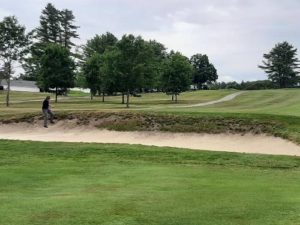
VESPER VELVET AND HER LAKE SUNAPEE SISTER
Of course you can’t talk about Lake Sunapee Country Club without at least mentioning Vesper Velvet.
Vesper Velvet, contrary to reports, is not a James Bond heroine. It is, instead, one of the finest old school strains of bent grass ever cross-bred for golf.
“Vesper Country Club in Massachusetts, [Author’s Note: halfway between Lake Sunapee and Boston], had a legendary head superintendent named Manny Francis, a Portuguese fellow who was there forever. He loved to tinker with cross-breeding turfgrasses, and he developed a strain of bent grass called Vesper Velvet that became the standard for many years at a lot of great New England courses,” noted Doug Homan, owner of Lake Sunapee, and grandson of Henry Homan, who operated the club from its inception. As a youngster, Doug Homan actually caddied at the club for members that were at Lake Sunapee when Ross designed the course, and he can recall almost seven decades of the club’s events.
“My grandfather, who knew Manny well, cultivated his own close-cousin cross-strain called Lake Sunapee Velvet, and it’s our entire playing surface, with the exception of our 10th green, which is actually Vesper Velvet.”
Lake Sunapee’s turf was so hardy and sustainable that, like its sister Vesper Velvet, it became a go-to, must-have option for clubs throughout the northeast. For many decades, other clubs would pay for sod to be delivered from Lake Sunapee to their club, and Lake Sunapee would sell off acres of extra sod, roll it up, and truck it to clubs all across the northeast who would then unroll it like a carpet. Immaculate Lake Sunapee Velvet was so in demand that it was even shipped to and used at Fenway Park and the White House lawn.
“We even sold sections of grass off the 16th fairway more than once during tough economic times,” Homan recalled.
Sadly, Vesper Velvet’s heyday has passed; it didn’t thrive in warm weather climates. Moreover, it tends to be soft and grabby as opposed to modern golf’s faster, firmer playing surfaces. On Velvet you can play darts with your irons, but you can’t putt from far off the green. Moreover, with thick, clingy rough making it seem more like Vesper Velcro, it does sometimes save your ball from perdition if you hit one off line, but it never rolls and tends to sink, yet another reason why Lake Sunapee plays much longer than the scorecard reads. Still, the greens are as smooth as glimmerglass, and the playing surface is immaculate.
NEW HAMPSHIRE’S PIN IN THE AMERICAN GOLF MAP
Charming, warm, and welcoming, Lake Sunapee is so eminently natural, you feel as though you’re either on one of the great English heathland courses, or perhaps somewhere in the Carolina low country. And it’s so timeless, you feel as though you’ve been transported back in time to the Golden Age of Golf. Lake Sunapee deserves to be considered among Ross’s best and most underrated private clubs, along with White Bear Yacht Club, Roaring Gap, and Minikhada, all first rate designs, tucked sleepily in out-of-the-way places.
New Hampshire’s pin in the American golf map, and an important historical marker in Donald Ross’s timeline, Lake Sunapee needs and deserves more attention. It may be off the beaten path for anyone not from Boston or Rhode Island, but it’s well worth the ride. For Bostonians, it’s just a quick 75 minute jaunt up I-93, the building of which greatly helped to swell Lake Sunapee’s membership.
And right on cue, it was a Bostonian whose words suddenly echoed like the report of a gunshot through the New Hampshire trees.
“That one! Right there!”
I wasn’t expecting such excitement from my Wingman golf and ski buddy, normally so stoic on and off the golf course. He was pointing at a condo just past the left side of the 10th tee box, one on the end, with a view up the fairway.
“I’m buying a condo, and I’ll use it for both golf and skiing,” he finished, beaming a satisfied smile. He’s been actively looking too, egged on by me.
I mean golfing and skiing: that’s what I call multi-purposing. I love the idea. Who wouldn’t?


